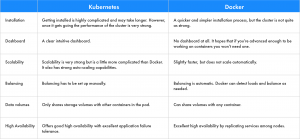Container Orchestration: Kubernetes & Docker Swarm
Kubernetes and Docker Swarm dominate the rapidly evolving container orchestration market, but which one should you choose?
Today, app development is moving fast and only the most agile of businesses will be able to keep up. As the focus moves towards speed and innovation, attention is shifting increasingly towards container orchestration. Its goal is to manage the life-cycles of containers in a dynamic environment. It automates many key tasks and is a key tool in accelerating the path to digital innovations.
However, with so many options available, navigating this arena can be confusing.
Two of the leading names in this area are Kubernetes and Docker Swarm. Both provide excellent functionality and usability, and each has a loyal base of dedicated fans, but there are important differences between the two that can help you decide which one to use.
Container Deployment with Kubernetes
Harnessing years of experience at Google, Kubernetes is an open source platform for container deployment operations, automation and scaling across clusters of hosts. It’s a production-ready enterprise level modular platform, ideal for deployment in any architecture. Kubernetes works by distributing the load across different containers. It places containers into groups, naming them as logical units and mitigating the problems that arise with running applications in public and private clouds. The key selling points with Kubernetes are easy scalability, portability across environments and flexibility.
Docker Swarm – The Container Orchestration Platform
First things first – we need to remember the difference between Docker and Docker Swarm. While Docker is just a containerization platform, Docker Swarm (more commonly known as Swarm) is an open source container orchestration platform. As Docker’s very own container’s orchestration, this platform is ideal for anyone already working with containers. Any software or services that are already run on Docker will also work well on Swarm. Swarm focuses on offering a powerful but simple and accessible solution. It is designed to be easy to work and operate for users and offer a resilient single point of failure architecture. As the name suggests, Swarm takes a collection of Docker hosts and turns them into a single host or a swarm. It is accessible, intuitive and easy to use. It is a valuable tool for people who are introducing themselves to the orchestration environment or have more than one cloud platform.
Kubernetes Vs Docker Swarm – A Comparison
Both Kubernetes and Docker Swarm are designed to do the same job, but both work in slightly different ways. The best way to compare them is to look side by side and some of their functions and features.
Getting Started
Installing Docker Swarm couldn’t be easier. All you need is two commands – one from the worker’s end and another from the manager’s and you are good to go. From there you are ready to head off and begin your deployment. Kubernetes is much more complicated. You first need to bring up your cluster, then define an environment and a pod before bringing up your dashboard. Only then can the cluster be used.
Dashboard
This is one area where Kubernetes wins hands down – mostly because it has one. Once you’ve started, you have a clear dashboard containing all the key information you need. Docker Swarm, on the other hand, has nothing. There is no dashboard.
Scalability
Both platforms are strong in terms of scalability. The one you prefer will depend on where your priorities lie. Docker Swarm goes for speed while Kubernetes offers an all in one solution. Kubernetes provides stronger guarantees about cluster state and a unified set of APIs.
High Availability
Both offer high availability in slightly different ways. Kubernetes has pods distributed among nodes which provide good tolerance to application failure. Kubernetes can detect unhealthy pods and get rid of them ensuring the delivery of high availability. With Swarm, its services can be replicated among its nodes. Swarm manager nodes take responsibility for the entire cluster and handle all the node resources.
Auto-scaling
Kubernetes wins this category. Its nodes are intelligent enough to analyze your load and scale up or down depending on your requirements. It’s intelligent enough to analyze loads and scale up or down as it needs to. Docker Swarm, in contrast, tends to crumble under pressure.
Balancing
Here, though Kubernetes has ground to make up. While balancing settings often have to be adjusted by hand, Docker offers auto-balancing. Because it has no concept of pods all the containers can easily discover each other with an IP address. As long as the nodes are connected to the cluster this will happen automatically.
At the risk of sitting on the fence, both offer plenty of functionality. They perform most of the same jobs but differ slightly in how they deliver them. The biggest difference, though, comes in complexity. Kubernetes is more complicated and will require a certain level of training. It is perhaps more suitable for high-performance applications. Docker is a little simpler and will be extremely popular among developers looking for speed of application and to get innovations to market more quickly.
Recommended Blogs:
Kubernetes in DevOps is the future of agility in business
Containers redefining software development process and maintenance
Getting Real with Containers – How to ace the pace of cloud migration
Making Infrastructure as Code a Better framework with Containers
- Meet Our AWS Ambassador – Siva Chandrababu - July 7, 2021
- Meet Our AWS Ambassador – Rajkumar Murugesan - July 7, 2021
- Kubernetes Versus Docker Swarm: Which One to Use? - June 17, 2021








Comments